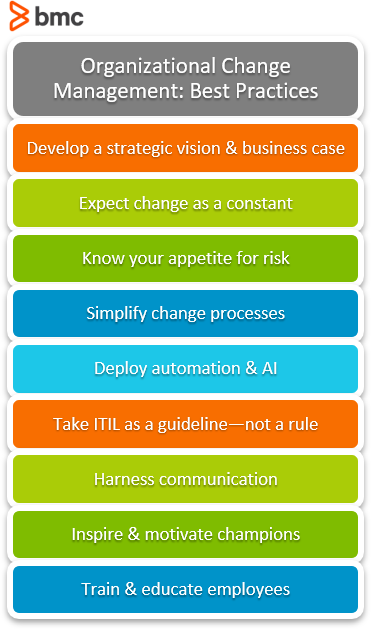Organizational change is difficult, but necessary.
To keep up with the changing landscape of technology and business, you need to be willing to change your own organization. Organizations must adapt and improve their capacity to take advantage of the opportunities offered by technology adoption and find ways to manage risk.
In order to achieve these goals, you must practice effective change management. The practice is also a critical success factor for successful digital transformation.
What is change management?
Change management refers to the discipline that aligns a change initiative with your company’s strategy and objectives. A change could be small—something the service desk does on a daily basis—but it can also encompass the entire organization.
(This article looks at organizational change. For service management changes, explore types of changes and key roles in change management.)
How to change the organization
Some changes involve organizational structure, strategies, culture, systems, operations, technology systems and, at the heart of it, the employees. The role and interactions of human resources in organizations therefore must be managed effectively to achieve these goals.
Management involves execution of all-important functions that can facilitate change. In the age of digital transformation, change management has emerged more of a scientific and artistic endeavor than an administrative task. For example, consider these key management functions inherent in change:
- Planning. Devising a future vision and preparing the necessary resources.
- Organizing. Establishing a structured approach for transforming individuals, systems, and strategies.
- Staffing. Equipping the organization with the necessary human resources.
- Leading. Influencing change in the right direction.
- Controlling. Following up, maintaining, and aligning continuous change efforts.
To perform these change management functions, you’ll need to adopt a change management model and framework that describes the various stages and evolution of the change project during its lifecycle. These models typically capture two things:
- The steps that an organization
- The objectives of the changes
Take, for instance, the change management model proposed by Kurt Lewin, a pioneer of the change management discipline in psychology and management sciences. His model involves the following simple concepts that can be compared to the matter state of water:
- Unfreeze. Address existing behaviors.
- Change. Act upon the planning and preparation for change.
- Freeze. Reinforce the new state of behavior.
Best practices for organizational change
Change management is a vast and complex subject that is critical to the success of any digital transformation initiative. How do we make sure that the unfreeze-change-freeze stages of the change management process deliver the best outcomes?
These industry-proven best practices can help you get started with your change initiatives:

Develop a strategic vision & business case
Every change initiative should have a strategic vision that aligns with organizational goals.
The change should be compelled as an actionable business case with the business strategy serving as its framework. The management process should operationalize and optimize transformation based on this strategic vision.
(Use our template for organizational change.)
Expect change as a constant
Establish a culture of constant change as part of a strategy toward continual improvement. These changes can take the form of:
- Ongoing investing into workforce training, acquisitions, and partnerships
- Changing strategic directions
Know your appetite for risk
When you follow a high-risk transition without adequate preparation and risk management, your digital transformation initiative will fail. Put in place a chance management process that can anticipate and protect against risks caused by drastic changes in:
- Operations
- Systems
- Strategies
- Business models
(Learn how to manage service management risk.)
Simplify change processes
An easy change process is likely to draw consistent stakeholder and user buy-in. By simplifying the transition, users are less likely to resist change or revert to a previous state of operations.
Deploy automation & AI
Take advantage automation technology to drive the management process with data-driven insights and intelligence. Eliminate repetitive manual processes that are more likely to introduce human errors.
Take ITIL® as a guideline, not a hard rule
ITIL implementations can take as many flavors as the number of organizations adopting the framework. It’s important to understand that this flexibility can make it easy for the organization to adopt ITSM practices that work best for their use cases.
(Explore the ITIL practices of change management & change enablement.)
Harness the power of communication
Communicate the right, complete, and consistent message across and throughout the organization. Collaborate across teams and individuals on change plans, process, and goals to avoid unwelcome surprises that introduce resistance at the employee level.
Imran Khan, SVP of Customer Success at BMC Software, explores just how essential communication is to change. He says:
First, you need to persuade people to embrace the new solution by effectively communicating the what, the why, and the how surrounding the change. Second, you must clearly communicate the benefits the solution offers to each individual affected by the change. That means painting an appealing picture of where each stakeholder fits into the desired future state.
Inspire & motivate champions
Many change initiatives fail because organizations fail to communicate the rationale behind their transformation program. Employees want to know the “why” before they can commit to any drastic change in their daily routine.
Avoid this by inspiring and motivating the change champions. Doing so at scale across the organization requires a great deal of inspiration and motivation for end-users to support the efforts from the ground-up.
Train & educate employees
Finally, a change effort is only good as long as it is sustained and leveraged to its maximum potential.
For instance, installing new technology systems are useful only when users get across the learning curve and are able to comfortably adopt the new technology as well as the associated operational changes.
Change is hard, but can be managed
We all know that change is difficult. Organizationally, it requires the right kind of persuasion to get employee buy-in. Consider the tone of your change campaign—is it loud and demanding to be looked at, or soft and steady with a confident beat?
Which fits better within your culture? What are the risks of doing it the opposite way?
Related reading
- BMC Business of IT Blog
- The Chief Transformation Officer Role Explained
- What Is GRC? Governance, Risk, and Compliance Explained
- The Organizational Death Spiral: See It, Avoid It
- IT Management: Get Started with Help from Two Experienced Joes
- Top ITSM Trends in 2021
These postings are my own and do not necessarily represent BMC's position, strategies, or opinion.
See an error or have a suggestion? Please let us know by emailing blogs@bmc.com.






